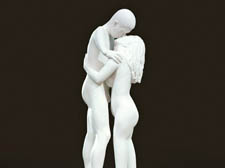|
|
 |
| |

Kiss, 2001, by Marc Quinn (1964-). Private collection |
The Love Exhibition at the National Gallery - A moving display of affection
On a hot day in town, all you need is Love, as Gerald Isaaman discovered at the National Gallery’s touring exhibition
LOVE is fun, sad, a joy. You will find it all at the National Gallery, as I did, dashing from the boiling sun into the cool-controlled atmosphere of the National’s touring Love exhibition.
There are some 30 wonderful works to see, dating from the 16th century and ranging from Raphael, Goya and Turner to Alma-Tadema, Holman Hunt and Hockney.
A truly fun item is Yoko Ono’s conceptual Secret Piece 111. It invites visitors to write a message to a loved one or create an erotic image to stick on to a blank canvas. Squares of virgin paper are available to make it easy, the result a shower of declarations, poems, hearts and kisses in languages galore, some a delight to read, others banal expressions such as “We will stay together forever” and “Alfredo – I love you!”
Such is the fascination it arouses, giggling young girls in particular gather round to plant expressions of their passion on the wall, which bulges like a curtain you can lift to gaze at the secret stories hidden beneath.
“It gets so packed with messages that they have to empty it every two days and start afresh,” the smiling nearby guard tells me. “I don’t know what happens to the ones they take away.”
The exhibition itself is one of similar stories, love in all its manifestations and disguises. So you can enjoy the classical nude, tiny-breasted full-length version of Venus in Cranach the Elder’s Cupid Complaining to Venus (circa 1525) and wonder why Cupid is covered with bee stings. Is he possibly telling us that pain can follow your amorous adventures, that agony and ecstasy naturally accompany affairs of the heart?
Equally up in the air is Chagall’s Bouquet with Flying: flowers in the blue of the night, Chagall’s dead wife, Bella, now an angel with wings made from her wedding veil in an expression the sadness of love lasting beyond the grave.
More down to earth is Joseph Wright’s 1770 double portrait of the newly wedded Mr and Mrs Thomas Coltman, a young, good-looking wealthy couple eloquently displaying their social status in sparkling sunshine.
At a distinctly lower level, there is the brooding intimacy of Stanley Spencer’s Beatitudes of Love: Contemplation, dating from 1937. The odd couple gazing at each other in “married bliss” are in fact ungainly Stanley himself and his large lover, locked together in what he described as one of his “sex pictures”.
For sophistication it is difficult to beat Alma-Tadema’s The Unconscious Rivals of 1893, two immaculate women lazing in a sumptuous Roman villa, unaware that they are the jealous rivals for the same man.
And for sheer physical sexual force there is Dante Gabriel Rossetti’s portrait of his statuesque lover, his friend William Morris’s wife, Jane, modelling in the role of the Astarte, an ancient Middle Eastern goddess of love. Here is the green shrouded temptress of desire, with one hand under her breast and the other about to remove the jewelled girdle round her hips. What a dazzle.
It is an exhibition to be enjoyed while it lasts, as with the moving messages on Yoko Ono’s canvas, two of which from tourists declared: “I love London!”
|

|
 |
|
 |
|

